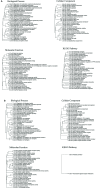Regulation of Pain Genes-Capsaicin vs Resiniferatoxin: Reassessment of Transcriptomic Data
- PMID: 33192502
- PMCID: PMC7658921
- DOI: 10.3389/fphar.2020.551786
Regulation of Pain Genes-Capsaicin vs Resiniferatoxin: Reassessment of Transcriptomic Data
Abstract
Emerging evidence has shown a strong association between neuropathic pain and chronic diseases. In recent years, the treatment of neuropathic pain has attracted more attention. Natural products, such as capsaicin and resiniferatoxin, have been well utilized to treat this disease. In this study, we aim to compare the regulatory effects of capsaicin and resiniferatoxin on pain-related genes as well as on genes with no direct association with pain. Public transcriptomic and microarray data on gene expression in the dorsal root ganglia and genes associated with TRPV1 (+) neurons were obtained from the GEO database and then analyzed. Differentially expressed genes were selected for further functional analysis, including pathway enrichment, protein-protein interaction, and regulatory network analysis. Pain-associated genes were extracted with the reference of two pain gene databases and the effects of these two natural drugs on the pain-associated genes were measured. The results of our research indicate that as compared to capsaicin, resiniferatoxin (RTX) regulates more non pain-associated genes and has a negative impact on beneficial genes (off-targets) which are supposed to alleviate nociception and hypersensitivity by themselves. So, based on this study, we may conclude that capsaicin may be less potent when compared to RTX, but it will elicit considerably less adverse effects too. Thereby confirming that capsaicin could be used for the efficient alleviation of neuropathic pain with possibly fewer side effects.
Keywords: DEGs (differentially expressed genes); TRPV1; capsaicin; neuromodulation; neuropathic pain (NP); resiniferatoxin.
Copyright © 2020 Singla, Sultana, Alam and Shen.
Figures











Similar articles
-
Similar and different effects of capsaicin and resiniferatoxin on substance P release and transient receptor potential vanilloid type 1 expression of cultured rat dorsal root ganglion neurons.Methods Find Exp Clin Pharmacol. 2010 Jan-Feb;32(1):3-11. doi: 10.1358/mf.2010.32.1.1444424. Methods Find Exp Clin Pharmacol. 2010. PMID: 20383340
-
Brain-derived neurotrophic factor redistribution in the dorsal root ganglia correlates with neuropathic pain inhibition after resiniferatoxin treatment.Spine J. 2010 Aug;10(8):715-20. doi: 10.1016/j.spinee.2010.03.029. Epub 2010 May 7. Spine J. 2010. PMID: 20452292
-
Antinociceptive desensitizing actions of TRPV1 receptor agonists capsaicin, resiniferatoxin and N-oleoyldopamine as measured by determination of the noxious heat and cold thresholds in the rat.Eur J Pain. 2010 May;14(5):480-6. doi: 10.1016/j.ejpain.2009.08.005. Epub 2009 Oct 1. Eur J Pain. 2010. PMID: 19800272
-
Therapeutic targeting of TRPV1 by resiniferatoxin, from preclinical studies to clinical trials.Curr Top Med Chem. 2011;11(17):2159-70. doi: 10.2174/156802611796904924. Curr Top Med Chem. 2011. PMID: 21671878 Review.
-
Intravesical neuromodulatory drugs: capsaicin and resiniferatoxin to treat the overactive bladder.J Endourol. 2000 Feb;14(1):97-103. doi: 10.1089/end.2000.14.97. J Endourol. 2000. PMID: 10735579 Review.
Cited by
-
Natural Product-Based Studies for the Management of Castration-Resistant Prostate Cancer: Computational to Clinical Studies.Front Pharmacol. 2021 Oct 19;12:732266. doi: 10.3389/fphar.2021.732266. eCollection 2021. Front Pharmacol. 2021. PMID: 34737700 Free PMC article. Review.
-
Resiniferatoxin: Nature's Precision Medicine to Silence TRPV1-Positive Afferents.Int J Mol Sci. 2023 Oct 10;24(20):15042. doi: 10.3390/ijms242015042. Int J Mol Sci. 2023. PMID: 37894723 Free PMC article. Review.
-
Editorial: Application of plant secondary metabolites to pain neuromodulation, volume II.Front Pharmacol. 2022 Sep 26;13:1013063. doi: 10.3389/fphar.2022.1013063. eCollection 2022. Front Pharmacol. 2022. PMID: 36225584 Free PMC article. No abstract available.
-
Identification of Hub of the Hub-Genes From Different Individual Studies for Early Diagnosis, Prognosis, and Therapies of Breast Cancer.Bioinform Biol Insights. 2024 Sep 4;18:11779322241272386. doi: 10.1177/11779322241272386. eCollection 2024. Bioinform Biol Insights. 2024. PMID: 39239087 Free PMC article.
-
Natural Kinase Inhibitors for the Treatment and Management of Endometrial/Uterine Cancer: Preclinical to Clinical Studies.Front Pharmacol. 2022 Feb 21;13:801733. doi: 10.3389/fphar.2022.801733. eCollection 2022. Front Pharmacol. 2022. PMID: 35264951 Free PMC article. Review.
References
LinkOut - more resources
Full Text Sources
Miscellaneous

